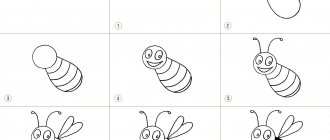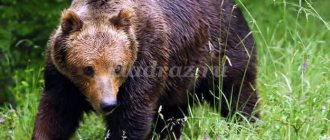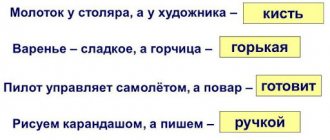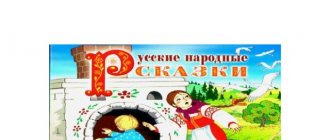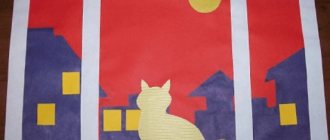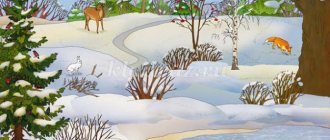LiveInternetLiveInternet
Quote from Tatyana57
Read in full In your quotation book or community!
SPEECH DEVELOPMENT. LEXICAL TOPIC “WILD BEASTS OF OUR FORESTS AND THEIR CHILDREN”
CHILDREN SHOULD KNOW THE NOUNS: bear, she-bear, bear cub, wolf, she-wolf, cub, hare, hare, little hare, fox, fox, fox, fox, hole, lair, squirrel, squirrel, hollow, moose, elk, calf, horns, hedgehog , hedgehog, hedgehog, wild boar, female boar, boar, badger, badger, little badger, forest, clearing, cheat, paw, wool, claws, nose, ears, hooves, tail. Muzzle, snout, mouth, animals, cubs, bushes, trees, mouse, lynx, raccoon, beaver, deer, marten, fangs, sable, mink, mole, den, connecting rod. ADJECTIVES: brown, clubfooted, cunning, predatory, gray, tireless, scary, thick (fur), red, wild, fluffy, dexterous, careful, fast, white, cowardly, long-eared, lop-eared, sensitive (ears), oblique, timid, velvet, prickly, wolf, striped. VERBS: wanders, climbs, roars, tears (bast), jumps, gallops, growls, grins. Hunts, escapes, howls, gnaws, digs, runs, “gave a go,” collects, stores, grunts, sniffs, sniffs, listens, hides, pricks, sneaks, sucks, lies down, falls. CHILDREN SHOULD BE ABLE TO NAME THE FAMILY: Bear, she-bear, little bear. Hare, hare, little bunny... SELECT NOUNS TO ADJECTIVES: Brown, club-footed, clumsy -... Gray, toothy, scary -... Cunning, fluffy, red-haired -... CALL MOM: The bear's cub, the fox's cub..., the bunny's... WHO HAS A VOICE : The fox yelps, the bear growls, the wolf howls... WHO LIVES WHERE: A fox lives in a hole. In the den - ... In the den - ... In the hollow - ... TO WHOM WE WILL GIVE WHAT: Meat - to the wolf, raspberries - ..., honey - ..., carrots - ..., nuts - ... SELECT NOUNS TO THE VERB: Hunts - ... Sneaks - ... Howls - ... Bites - ... Jumps - ... Tricks - ... Waddles - ... SELECT SIGNS: Wolf (which one?) -.... Fox (what?) - ... Hedgehog (what?) - ... SELECT ACTIONS: Bear (what is he doing?) - ... Fox (what is he doing?) - ... Hare (what is he doing?) - ... CORRECTLY ANSWERING THE QUESTIONS: Whose? WHOSE? WHOSE? WHOSE? Track - wolf, fox, hare... Ears - bear, hare, squirrel... Head - elk, hedgehog, wolf, fox... FORM NEW WORDS USING PRESIDENTS: Walks - moves, leaves, goes around, passes, enters, enters, descends, finds , leaves, approaches, reaches, comes, leaves, passes. COMPLETE A DESCRIPTIVE STORY ACCORDING TO PLAN. What is the name of? Where does he live? What kind of home does he have? What is the appearance? What habits? What does it eat? How does it get food? What are his enemies? How to defend yourself? What is the cub's name?
The fox is a predator. The fox mainly hunts mice, gophers, and less often hares. The fox cunningly catches hedgehogs. She rolls the hedgehog to the water, he straightens his spines in the water and swims to the shore. This is where the fox is waiting for him. The fox lives in a hole, and in the spring the fox gives birth to cubs. The squirrel is a rodent. She eats nuts, berries, mushrooms, and pine cones. The squirrel has sharp claws. This helps her quickly climb the tree. The fluffy tail serves as a parachute for the squirrel. A squirrel lives in a hollow and insulates its nest with down. In summer the squirrel is red, and in winter it is gray. In winter, the squirrel sleeps almost all the time and rarely looks out of the hollow. The squirrel is a thrifty housewife. She prepares nuts for the winter and dries mushrooms on tree branches. In the spring, squirrels give birth to squirrels. The wolf is a predatory animal. Wolves live in a pack. A pack is a wolf family. Wolves almost always hunt for sick, weak animals. Wolves hunt at night. Wolves live in a den to raise wolf cubs; wolf cubs appear in the spring. The bear is an omnivore. He loves to eat honey, berries, fish, ants, roots, but can also attack humans. The bear is clumsy in appearance, but easily climbs trees and runs quickly. The bear builds a den for himself from twigs, fallen trees, and moss. In winter, a mother bear gives birth to cubs. If a bear has accumulated little fat since the fall, it wakes up in the winter and walks through the forest hungry. For this the bear was nicknamed the connecting rod. The hare is a rodent. The hare feeds on grass, leaves, shrub bark, mushrooms, and roots. In winter, it chews the bark of trees. The hare is white in winter and gray in summer. This helps him hide from predators. Long, fast legs also save the hare from its enemies. The hare runs up the mountain at a run, and down the mountain somersaults. The hare lives under a bush in the summer, and digs a hole in the snow in the winter. In the spring, the hare gives birth to baby hares.
EXERCISE “GUESS AND TELL”. This beast lives in the forest, gnaws the bark of the trunks. In the summer in a gray fur coat, and in the winter in a white one. (Hare) - What does the hare eat in the spring? (grass, leaves). The owner of the forest wakes up in the spring, and in winter, to the howl of a blizzard, he sleeps in a snowy hut. (Bear) -What does a bear eat? (roots, grass, beetles, mice, hares). You and I recognize the animal by these two signs: He wears a gray fur coat in the winter, and a red fur coat in the summer. (Squirrel) - What does a squirrel feed on? (cones, nuts). All winter between the Christmas trees I slept through a bag of needles. “F-f-f-f—stop sleeping, It’s time to get up!” (Hedgehog) - What does a hedgehog eat? (bugs, worms, mice). Gray and toothy. Howls on a rainy day: “Uh-uh...” (Wolf) - What food does a wolf eat? (meat - catches mice, hares, sheep). Fluffy tail, golden fur, lives in the forest, steals chickens in the village. (Fox) - Who else does the fox catch? (mice, hares).
"Wild and Domestic Animals"
1. Introduction to the situation.
Didactic tasks: Motivate children to engage in gaming activities.
In the morning, when children enter the group, they see animal toys (cat, dog, wolf, fox, hare, bear, cow, sheep, etc.). They ask the teacher why we have so many animals? Where are they from?
Educator: These animals were given to us, but I don’t know what to do with them. What do you think we can come up with? Children: offer to play with animals.
2. Updating knowledge.
Didactic objectives : Update children's knowledge about animals.
The game “Wild and Domestic Animals” is held
Didactic tasks: consolidating children's knowledge about animals. The ability to classify them.
Exercises are carried out with wild and domestic animals.
Didactic tasks: organize active recreation for children, develop imagination, coordination of movement.
To the music, children perform movements and show (depict) animals.
3. Difficulty in a game situation.
Didactic tasks:
- Create a motivational situation for the formation of children’s ideas about animals in their habitat;
- To form experience, under the guidance of a teacher, of fixing the difficulty and understanding its cause.
Educator: I suggest you build houses for animals. What kind of houses do you think we will build for them? Let us remember where the cat lives? Where does the cow live? Where does the fox live? Etc.
Children's answers: house, hole, kennel, forest, etc.
Educator: can we build one house for everyone?
Children's answers: No
Educator: Why?
Children's answers: wild animals live in the forest, and domestic animals live next to humans.
Educator : I suggest you divide into groups. One group will build a habitat for domestic animals, the other for wild animals.
4. «Discovery" of new knowledge.
Didactic task:
- Organizing a dialogue between a teacher and children aimed at discovering new knowledge.
- Train self-control skills, mental operations - analysis, comparison, generalization, develop logical thinking, initiative, creativity, speech.
The teacher explains to the children that everyone has their own home, their own bed, their own toys. So you and I will build a model for our animals. For pets, we will build a barn, put up a fence, and plant trees and flowers in the yard.
And for others the forest, holes, river.
Children's answers: children complete tasks with the help of a teacher.
Educator: Our layouts are ready, where do you think is best to put them?
Children: to a corner of nature.
Educator : you can come up and play with them at any time.
Artistic creativity “What to feed the animals”
Didactic tasks: develop imagination, creative abilities.
Children independently draw the products that will be fed to the animals. (cabbage, carrots, bread, water in a bucket, etc.)
5. Incorporation of new knowledge into the child’s system of knowledge and skills.
Didactic task:
- Consolidation of new knowledge in children.
- Train mental operations - analysis, comparison, analogy, develop imagination, logical thinking, speech.
Educator : oh, our animals are sick, why do you think?
Children : we fed them poorly, they caught a cold, etc.
Educator: who knows which doctor treats animals?
Reading the book “Doctor Aibolit”
Didactic task: using new knowledge together with previously acquired knowledge.
Educator: will he cure our animals?
Children's answers: no (yes)
Educator: right, of course he will cure them, give them raspberries, lemon, honey, chamomile, linden.
Theatrical performance for children “Doctor Aibolit”
Didactic task: to create conditions for the development of imagination, the ability to play a role, to bring the job started to the end.
6. Understanding.
Didactic task: to restore in children’s memory what they did during the day and create a situation of success.
What new have you learned? What did you like most?
Wild animals of the forest
Hare
The hare lives in the forest. He does not dig holes for himself, but hides in bushes, in recesses under roots, under branches, where he builds a winter hut for himself. The hare's main food is grass, hay, and young tree branches. The hare also eats vegetables, fruits and berries, if he can find them.
Fox
The fox is a wild animal. She lives in the forest, in a hole. The fox is a predatory animal. The main food of foxes is insects (beetles, earthworms) and small rodents (voles). If the fox manages to catch a hare or a bird, which does not happen very often, she will happily eat them too. Often foxes settle next to humans and steal poultry from poultry houses. Sometimes she can also feast on fish washed up on the shore. She will not disdain berries and fruits when she is hungry.
Wolf
The wolf is an animal of the forest. Wolves live in a den. Wolves hunt in packs, so they are able to catch large prey: elk, deer. The wolf will gladly treat himself to both the bird and the bunny. In hungry years, wolves can attack livestock, but this happens very rarely. Wolves are very cautious and afraid of humans.
Hedgehog
Hedgehogs live in the forest. They rarely dig holes themselves, more often they occupy someone else’s or build a nest among protruding roots, under a bush, in depressions in the ground, dragging there a lot of leaves, dry grass and moss. In winter, hedgehogs hibernate. Hedgehogs eat mainly insects. If they come across a snake, they might eat it too. Don't mind eating mushrooms, acorns, berries and fruits.
Brown bear
The brown bear is a wild animal of the forest. For the winter, the bear builds a den for itself and hibernates. The main food of bears is berries, roots, and mushrooms. If a bear finds a bird's nest, it will feast on eggs; if it finds a hive of wild bees, it will eat honey. The bear knows how to catch fish and eats it with pleasure. He can even eat a mouse if he manages to catch it. He will not disdain carrion either.
Squirrel
A squirrel lives in the forest. She finds a hollow in a tree and settles there. The squirrel eats berries, fruits, mushrooms, nuts, acorns and grains. Stores supplies for the winter, hiding them under roots or among tree branches so as not to starve in winter.
Desert Animals
Camel
Camels live in desert and semi-desert. They don't build housing. They feed on grass (both dry and fresh), tree branches, camel thorn, ephedra, wormwood, and chew saxaul branches. A camel accumulates nutrients in its humps, so it can go without food for a long time.
fennec
Fenech lives in deserts and semi-deserts. He digs himself a hole in the sand. Fennec fox is omnivorous. It feeds on insects, lizards, bird eggs, small rodents, and plant roots that can be dug up in the desert.
When the child has become acquainted with animals, their way of life, and nutrition, let him try to tell himself about what he remembers. Pictures and diagrams with an algorithm for composing a descriptive story will help with this >>
At first, you may not be able to get a coherent story, then try printing and cutting the cards above into sectors, and ask your child to arrange the pictures correctly.
More detailed stories for children about animals can be found on our website in the sections:
We enrich and activate our vocabulary. We consolidate knowledge of nouns:
squirrel, hollow, fox, hole, hedgehog, hare, wolf, lair, elk, bear, den, lynx, forest, deer, horns, hooves, body, fangs, wool, fur, needles, skin, mouth, paws, belly, claws;
verbs:
extract, jump, scour, howl, growl, squeak, roar, hunt, hide, yelp, snort, teach, guard, suck, loop, feast;
adjectives:
large, small, shaggy, shaggy, fluffy, strong, cunning, prickly, fast, dexterous, brown, toothy, clumsy, clumsy, beautiful, sharp, striped, powerful, flexible, clumsy, cautious, predatory;
adverbs:
quickly, deftly, slowly, dangerously, scary.
We teach a child to write riddles and descriptions about wild animals
. The first words in the riddle must be the words: this is an animal. The next words may be to clarify the size of the animal (large, small, small, etc.). Then you need to talk about the characteristic features of appearance (fluffy, shaggy, prickly, clumsy) and what the animal eats.
